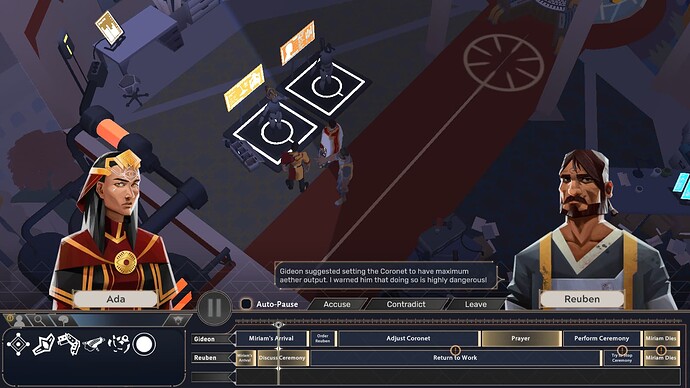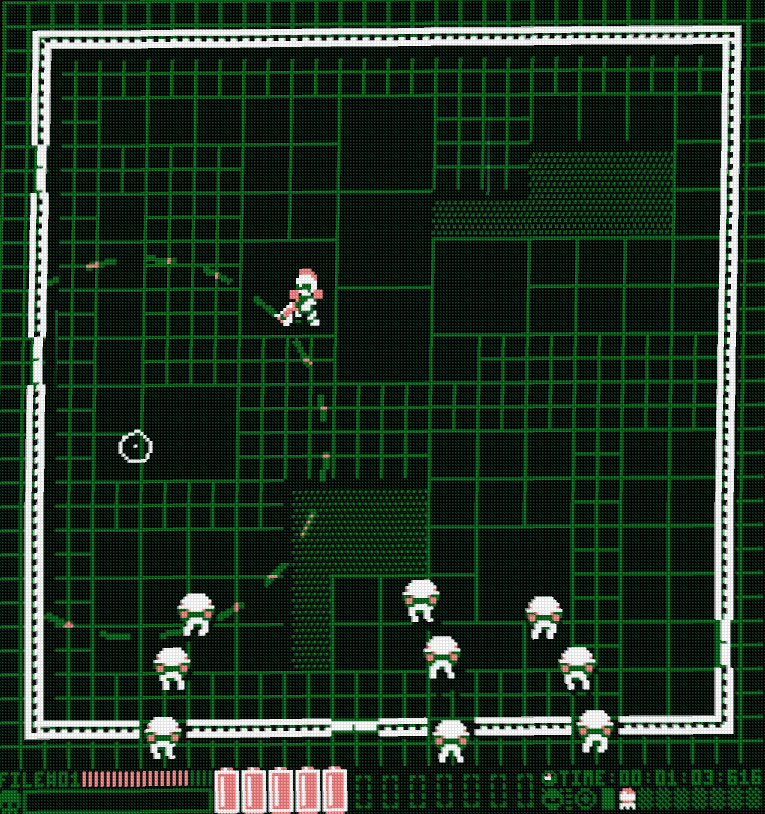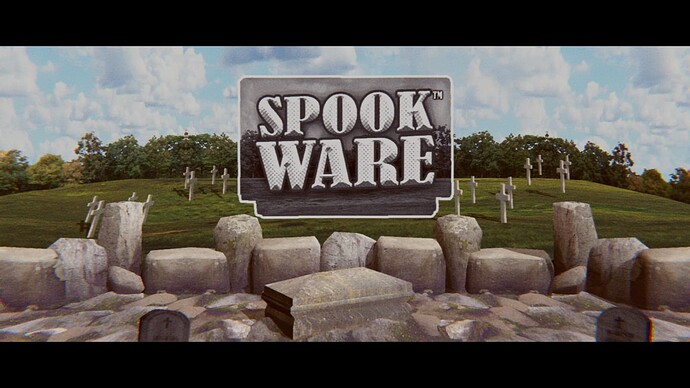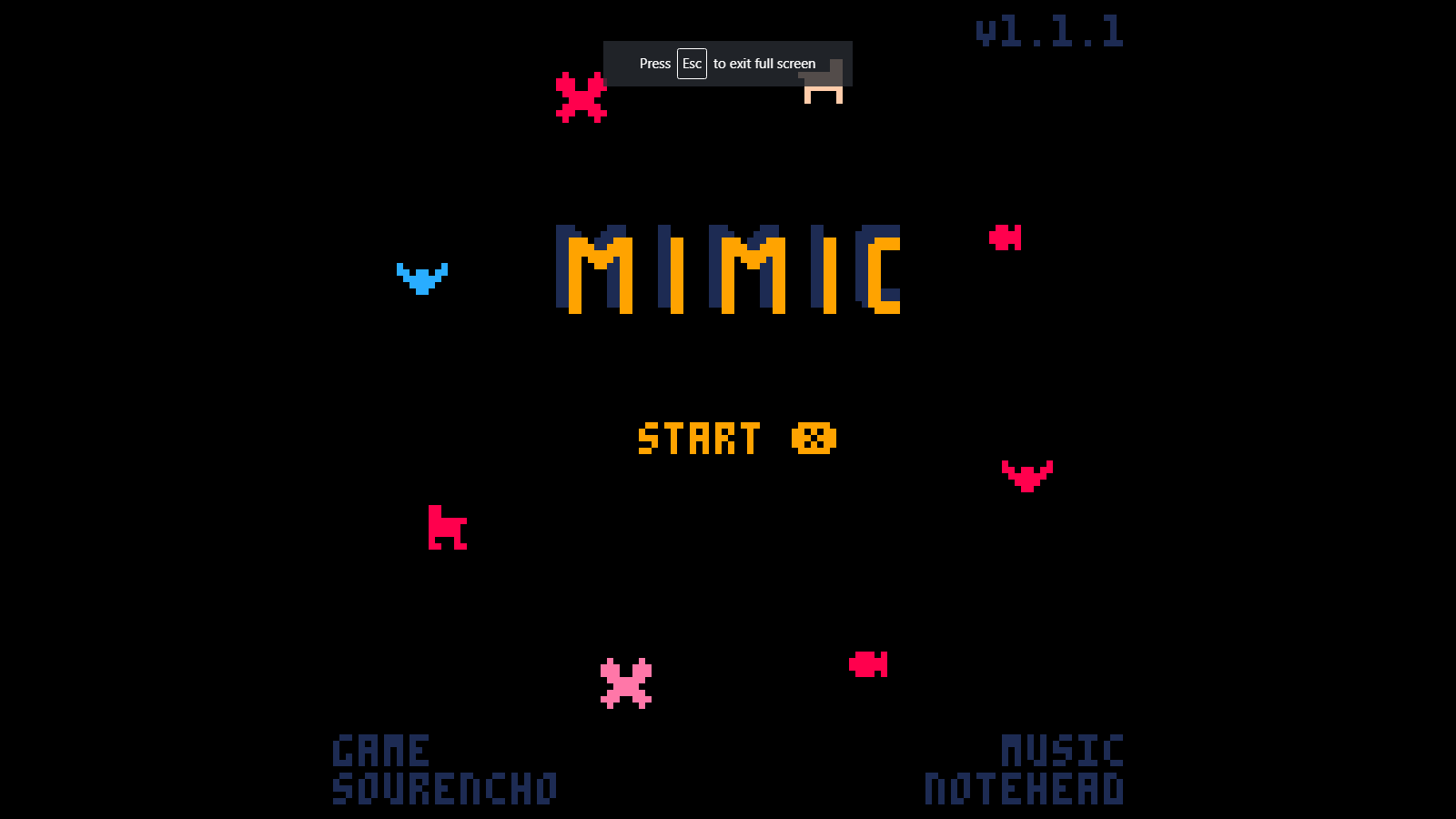So some weeks the random game that came up to play isn’t particularly good or interesting and from a dev whose country is currently war torn leaving one struggling with how to approach it… and then a random Steam puzzle game festival pops up and offers a way out. I played a bunch of random puzzle game demos, let’s talk about them instead! All of them, strap in or get out, we’re going long~
Putty Putter

Is it Sokoban?: Yes
Putty Putter is a golf puzzle game where you have to push one or more balls into one or more holes, but some genius made most of the balls too heavy to easily move. You have to weigh as much as the ball to move it, fortunately you can hold down a button to increase your size and hence weight by expanding in a given direction. The problem is that if you expand say three back then once up you will try to grow up from every available surface, so if you are three long horizontally expanding up or down will make you a 3x2 block unless something prevents that; that’s where the puzzling comes in. Use the environment to shape your growth, be careful as moving rather heavy balls requires transforming the player character into some massive, difficult to maneuver shapes in order to get the balls to their homes.
Did I wishlist it?: No. I had a real tricky time wrapping my head around the central mechanic. Either they put a rather tricky puzzle way too early in the game or my brain just wasn’t processing this well so I hit a bit of a wall. Clever concept but looks like it wasn’t for me.
Meet me at Noon
Is it Sokoban?: No
Meet me at Noon is a control two different characters time loop game “inspired by the movie Tenet” according to its store page; I never saw it. What that means in practice is that the “day” character goes first, and then when the “night” character goes next the day character repeats their moves from the day. The thing is the two character repeat their moves differently, the day character during the following night basically rewinds and does their moves in reverse while in the multi-day puzzles the night character just repeats their motions exactly as performed the prior night. Generally the characters have to perform some actions in concert, such as one acting as a platform for another, so that they can both be on their goal spots at the same time and advance to the next puzzle.
This isn’t an entirely new concept, but the touch that helps here is that there is a move counter at the bottom of the screen that lets you know how many button presses you get during a day/night which both lets you plan ahead much easier and makes it much more manageable to sync up both characters and make sure they are at the right place at the right time. It takes away any reaction timing-esque player responsibility and just makes it so much easier to deal with than these games often are.
Did I wishlist it? Yes! It doesn’t feel like something I’ll definitely have to play someday but the smart choices it made makes it something that I want to check back on down the road once it is finished to see how it turned out.
Jelly is Sticky
Is it Sokoban?: Yes
On one hand this is at times the most straightforward sokoban game, with you having to get certain jelly squares onto certain marked tiles in order to solve the puzzle. On the other it isn’t because not only do you often play as the jelly square itself, said square is made of jelly and can change its shape by bumping into stuff, sliding part of its mass off against a wall or bumping into other sloughed off bits to grow larger. Let me grab that gif again.

Now while some jellies act like this, others will try and hold their shape, some are very sticky and some aren’t sticky at all. Often times these different types of jellies are in the same puzzle and you have to manage their differences to get by, while sometimes you get to do stuff such as having the manipulate a giant set of jelly lock tumblers to move a single square over one row. You know, the usual.
Did I wishlist it? Yes! It is hard to convey in writing but some puzzle games have this spark in them, either being just that clever or that well crafted that they shine. I can’t say for sure this game has that as it could easily be frontloaded or run out of ideas but as a demo it definitely made my ears perk up, real strong first impression here.
Inbox Unbox
Is it Sokoban?: Yes.
Is it Patrick’s Parabox?: Well… it is complicated. On first blush it certainly looks like it is straight ripping off Patrick’s game, but it turns out that beyond both being long gestating puzzle games (this one is already 2 1/2 years into development) they actually are both inspired by the same gamejam game from 2018 named sokosoko and seemingly got said creator’s blessing to build off their idea (BTW, said person coming up with and executing this concept in about 24 hours is absurd).
I haven’t played Parabox yet but apparently both games take the same central recursive sokoban concept in distinct directions. This game doesn’t appear to have the polished presentation of the other but its puzzles are definitely sharp and impressive. How certain blocks you can enter can appear as multiples or in different places, which means you can push a different block into one of them before removing it from another, already in these early demo stages offers a ton of mind expanding possibilities.
Did I wishlist it?: Yes! I mean, I did the same for Patrick’s game, so it only seemed fair.
Sokobond Express
Is it Sokoban?: Somehow no!
This is a mash-up of two previous Draknek games, Sokobond (where you push elements together to form chemical bonds and molecules) and Cosmic Express (where you lay out train routes), where you have to craft a route that takes an element by other ones in order to form a molecule. The thing is as it forms chemical bonds with other elements it drags the whole in-progress molecule along with it which is much bulkier and can bump into other things, which means you have to keep track of the orientation of the molecule you are crafting along with everything else.
Did I wishlist it? It was already on my wishlist. Even though it is made by someone else with the blessing (and publishing) of the original dev it looks like a neat idea. I got stuck hard near the end of the demo and had to quit for now, but it still seems likely to be a keeper.
Box to the Box
Is it Sokoban?: No.
This is a time loop puzzle platformer (unsure if the dev was also inspired by Tenet) where you play through with one character before hitting a button and playing through with a second while the first goes through a recorded loop of your previous actions (30 seconds max) from the first go around. Here the goal is to have at least one character reach the path out of the room. Unlike in the conceptually similar Meet me at Noon this plays much more like a straight puzzle platformer where you aren’t tied to a grid or move limit, which allows things to grow much more complicated (and not nearly as easy to sync up) before the demo even gets around to introducing a third character to control.
Did I wishlist it? No. By the end of the demo it had already grown very complicated and the implementation is a bit too harsh for what it asks. If you want to tweak what the first character does (and you will likely have to several times) you have to erase every character routine and start over, and by stage nine (the demo has ten, the full game fifty) it had already hit a point where I felt it was just too much work.
Kine

Is it Sokoban?: No.
Kine is a navigational puzzle game where you have to maneuver one of three anthropomorphized musical instruments (on their own, although I assume in the full game they will later have to work together) to an exit point. What sets the game apart, beyond the heavier than usual emphasis on presentation, is that all three instruments have unusual shapes that you can switch between different forms of at the press of a button. This makes figuring out how to position and rearrange them in order to get through a particular gap or space much trickier as as opposed to a normal cube these shapes all “roll” rather differently over these grid-esque layouts.
Did I wishlist it? No. It feels like something I should like and it is pretty clever but it didn’t really grab me. Also the nicer 3d presentation here requires maneuvering the camera and often obscures part of the puzzle, which is a downer. Still I can see others loving what this does.
Paquerette Down the Bunburrows
Is it Sokoban?: No.
This is a game where you chase after bunnies and try to grab them, as you really love bunnies. Unfortunately the bunnies would rather not be caught so they run away from you and try to avoid any obvious dead ends. This means you need to exploit some of their behaviors (their AI ain’t bad but it has some intentionally predictable “quirks”) in order to trick them into spots where you’ll be able to grab them, and if that doesn’t work you can always lay a trap on the ground as well to help.
Did I wishlist it?: No. It’s not a bad little test of learning AI behavior and exploiting its pathfinding but by the end of the demo I felt like I had already gotten enough of what it was going for that I didn’t need to see more. As a stand alone demo it isn’t bad though.
Lab Rat
Is it Sokoban?: Yes.
Man I can sense the eye rolling coming before I even start. Okay you play as a person chosen to run through a set of block pushing puzzles by an artificial intelligence that feels like it should owe GLaDOS royalties, who chimes in between puzzles to evaluate you or offer other clever metrics-based comments. This part is well done but also very… this so I could see it being a deal breaker for some.
The block pushing is a bit different than usual as you can drag a block side to side beyond just forward and backwards and even jump atop of it to get to the other side if blocked off, which means you don’t have to worry about things like getting stuck in a corner or other common worries in games like this. There are lasers that can charge up whatever surface of the block they hit which you can then no longer grab unless you get zapped yourself (which means you then can’t grab the non-zapped surfaces) with certain puzzles requiring certain sides of the block to be charged before it hits the goal space.
Did I wishlist it? Yes. I wasn’t going to, but as a reward for completing the last set of puzzles in the demo I got rewarded with some “multiplayer” ones, which was just not-GLaDOS putting some robots in the stage that grabbed the block while saying “I’m helping”; they just made things much trickier than they’d otherwise be and had to be worked around (I think I was then called antisocial afterwards when I said I didn’t care for their help). The thing is that was a very clever variant to toss in there which resulted in what was clearly the best set of puzzles in the demo. I’m now at least interested enough to see how the full thing ends up.
Rytmos
Is it Sokoban?: No.
Rytmos is a musical puzzle game where you select a surface on a cube and solve the puzzle on it, which is done by drawing a path that touches all the instruments before returning to the start point (once you start in a direction it only stops when you hit a wall). This creates a musical loop which plays constantly before you pick another surface and do the same, ending when you complete all six sides and the full song starts playing. A later set of puzzles had parts of the ground raising and lowering to the beat, which created some extra places where the path could be stopped and hence made figuring it out more puzzling.
Did I wishlist it?: No. It started to pick up in complexity a bit near the end but it starts off so easy that it was just kinda boring to me and I’m not convinced it’d ever ramp up enough to get past that.
Alephant
Is it Sokoban?: Kinda.
This is a hebrew language-based puzzle game. You see “Aleph is the first letter of the Hebrew alphabet, and it is generally silent”, however it can be combined with vowels to make a sound. This is why you push hebrew vowel-shaped blocks around a grid towards alephs, and also why the playable character is a silent elephant. Hebrew is underrated when it comes to puns.
The game itself doesn’t look impressive but that unique background convinced me to give it a shot, and I’m glad I did. While you do push stuff around a grid because the game is wordless you have to “Discover and understand apparently arbitrary rules” (creator’s words) in order to proceed (much like language itself?) and this proves to be an interesting enough challenge to keep pressing ahead. I got stuck near the end of the demo, and seemingly a bunch of players got stuck at a few different places, which isn’t unexpected given this approach, but I still appreciate what it is going for.
Did I wishlist it?: Yes. The demo goes from stage A to stage P (I got stuck on N) so I’m curious if they really gave away 60+% of the game in the free pre-release demo. This will remind me to check back on that. Also if the price isn’t that high I’d be interested to see what other arbitrary rules it has up its sleeve.
The Last Cube
Is it Sokoban?: Not in the demo at least.
First off, even thought it is different that’s one Gamecube ass looking logo.
This is a puzzle game where you roll a cube around, with one side generally being marked with a symbol that you must then roll said side down onto a grid square marked with the same symbol. If you get close to it the game prompts you to press a key to show what moves to take to do so, and I literally stopped for a second to ponder exactly what the point of this puzzle game is if it decides it is best to just tell you how to perform a part of the solution.
The game is out and has rather glowing reviews, yet after playing through about 2/3 of the demo I’m still not sure I have an answer to this question. You get some different marks that give you different abilities (dashing, being able to rotate your side around while staying on the same spot), and a similar mechanic has been used in games such as English Country Tune to great effect, so I can see how puzzles can be built around what is here. It also takes place in like over the top brutalist environments or mountains where solving a puzzle causes a platform to rise up and place you on an elevated one for the next one, and you can find hidden bonus stuff that gives you access to lore entries that I guess explain why you are the last cube and… it feels like such a parodic set-up yet so far it is nothing but straight faced and serious. It honestly confuses me.
Did I wishlist it? No. The regular asking price is $20 so even if it hits an eventual 75% off discount that’s still $5. I admit to curiosity, to wanting to better understand it, but not for $5+ and the 20+ hours the campaign asks for. Maybe if it pops up in a bundle someday.
Recursive Ruin
Is it Sokoban?: No.
A first person puzzle game built around a recursive world you can shift with the press of a button, it initially feels a bit more walking sim and talky but after ten or so minutes shows its real cards. You begin to play the game Recursive Ruin inside the game Recursive Ruin (yes, it has the same title screen) and end up in a kaleidoscopic world (stole that from the store page) that repeats infinitely as you try to make your way either towards the inner- or outermost sections… until you end up indoors and it is less hard to parse. Once you get past the initial trickiness of grasping the world your goal seems to be to find a block and take it to a receptacle to open the door to the next space, although this often involves having to shift the world state or leaving the block at one side of the recursion to retrieve it at the other.
Did I wishlist it?: No. Not as much a fan of first person puzzlers as I am other kinds and this feels like it has the potential to become more bothersome than intriguing. That’s how I felt about Antichamber as well FWIW.
Altered

Is it Sokoban?: Yes.
Much like Kine, here you control one of a few various characters (the demo focuses on one but gives brief tastes of two others) that can adjust their shape in various ways in order to make their way to the goal spot. This game is much more traditionally laid out with a top down view and has some block pushing elements, usually in order to lay them upon a switch that lowers a door blocking your route to the goal.
Did I wishlist it?: It was already on it. After I tried Kine it struck me that I should try the demo for this one to make sure I actually liked it. This game feels less ambitious, at least in terms of presentation, but more like a regular puzzle game and that seems to be a better fit for me personally. One of the characters had a truly “oh this could be a lot to deal with” feel to them, so that both intrigues and scares me a bit.
That’s it! I think Jelly is Sticky and Inbox Unbox were my favorites, but there were a bunch of fun ones in there.




















































































































